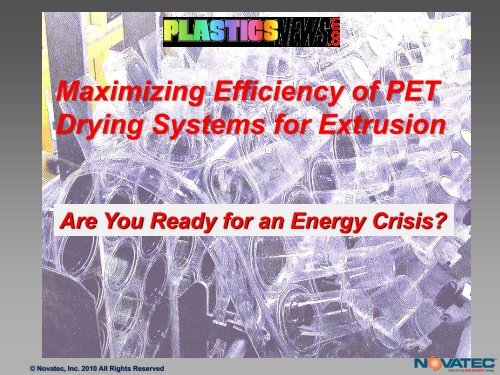Maximizing Efficiency of PET Drying Systems for ... - Plastics News
Maximizing Efficiency of PET Drying Systems for ... - Plastics News
Maximizing Efficiency of PET Drying Systems for ... - Plastics News
Create successful ePaper yourself
Turn your PDF publications into a flip-book with our unique Google optimized e-Paper software.
<strong>Maximizing</strong> <strong>Efficiency</strong> <strong>of</strong> <strong>PET</strong><br />
<strong>Drying</strong> <strong>Systems</strong> <strong>for</strong> Extrusion<br />
Are You Ready <strong>for</strong> an Energy Crisis?<br />
© Novatec, Inc. 2010 All Rights Reserved
Presenters:<br />
© Novatec, Inc. 2010<br />
Don Rainville<br />
Energy Consultant<br />
<strong>for</strong> Novatec, Inc.<br />
Mark Haynie<br />
<strong>Drying</strong> <strong>Systems</strong><br />
Product Manager<br />
Novatec, Inc.
© Novatec, Inc. 2010<br />
Are You Ready For<br />
an Energy Crisis?
The Future <strong>of</strong> Energy Costs<br />
Will this be the decade <strong>of</strong> the Energy Crisis?<br />
Doubling <strong>of</strong> rates is not uncommon<br />
• Cap & Trade is coming<br />
• Rising prices <strong>of</strong> oil, coal & natural gas<br />
• Increased demand by countries like China & India<br />
© Novatec, Inc. 2010
How Much Energy is Being<br />
© Novatec, Inc. 2010<br />
Wasted by Your Current Dryers<br />
…and What Can You Do About It?<br />
Minimizing<br />
Heat Loss<br />
Process<br />
Stability<br />
Process<br />
Control<br />
New/Improved<br />
Technology<br />
Energy<br />
<strong>Efficiency</strong><br />
System<br />
Configuration
Process Stability and<br />
Energy Management<br />
Risks To Process Stability:<br />
●Temperature Deviation<br />
● Inconsistent Moisture Content<br />
● Variable Material Supply<br />
Energy <strong>Efficiency</strong> cannot be achieved<br />
without Process Stability.<br />
© Novatec, Inc. 2010
Energy Based Design<br />
Energy Based Design analyzes energy consumption<br />
on the component and system level.<br />
Components<br />
• Dryer- process heater, regeneration heater<br />
• Radiant heat loss<br />
• Process machine efficiency<br />
System<br />
• Conveying heat loss<br />
© Novatec, Inc. 2010
Adapt Energy Consumption to<br />
the Load<br />
Causes <strong>of</strong> change in load conditions<br />
© Novatec, Inc. 2010<br />
Material temperature<br />
• Variation <strong>of</strong> 15% Winter to Summer<br />
Running less than system capacity<br />
• <strong>Systems</strong> typically run as much as 30% under rated<br />
throughput capacity<br />
Material moisture content
Look at Heat to Measure<br />
Energy <strong>Efficiency</strong><br />
Excess heat always leaves the system<br />
© Novatec, Inc. 2010<br />
Heat is lost through:<br />
• Conveying<br />
• Excessive air heating<br />
• Cooling coil<br />
• Inadequate insulation
Heating Material in Hoppers<br />
Equilibrium at startup<br />
Radiant heat loss is calculated<br />
as BTUs with a known CFM<br />
and temperature difference<br />
between the inlet and outlet.<br />
325° F<br />
350 ° F<br />
Do not measure as a percentage<br />
© Novatec, Inc. 2010
Heating Material in Hoppers<br />
<strong>Drying</strong> in steady state operation.<br />
Cold material entering the hopper is heated<br />
immediately cooling the return air.<br />
Excessive airflow results in a<br />
higher return air temperature.<br />
© Novatec, Inc. 2010<br />
140°F – 230°F<br />
350°F
© Novatec, Inc. 2010<br />
Controlling Return Air<br />
Temperature via Air Flow<br />
Reduces Heat Loss<br />
Steady Hopper<br />
Exit Temperature<br />
Process<br />
Heat Saved<br />
with<br />
VFD Control<br />
Uncontrolled<br />
Temperature
Maintaining Process Stability<br />
Primary Goals in the Hopper:<br />
• Constant material level<br />
• Constant distributed airflow<br />
• Maintain heat after air inlet<br />
© Novatec, Inc. 2010<br />
140°F – 230°F<br />
350°F<br />
Created<br />
Process<br />
Stability<br />
Lost
© Novatec, Inc. 2010<br />
Any Questions About<br />
Process Stability?
System Configurations<br />
…Affect process stability<br />
© Novatec, Inc. 2010<br />
and energy consumption
Look at Heat to Measure<br />
Energy <strong>Efficiency</strong><br />
Excess Heat Always Leaves the System<br />
System based heat loss<br />
• Cooling material by conveying<br />
Heat, Cool, Heat Cycle<br />
• Radiant Heat Loss<br />
Material in holding hoppers<br />
Dryers and crystallizers are mounted over the<br />
extruders in energy efficient systems.<br />
© Novatec, Inc. 2010
SYSTEM HEAT LOSS<br />
Conveying<br />
• Crystallizer to Dryer<br />
• Regrind Dryer to Blender<br />
• Dryer to Blender<br />
• Blender to Extruder<br />
Radiant Heat Loss<br />
• Blender<br />
Reheat Waste<br />
• Dryer after Crystallizer<br />
• Extruder<br />
© Novatec, Inc. 2010<br />
Energy Based Design<br />
System Analysis<br />
CRYSTALLIZER DRYER<br />
DRYER<br />
Classic Post<br />
Blending<br />
BLENDER<br />
EXTRUDER
SYSTEM HEAT LOSS<br />
Conveying<br />
• Crystallizer to Dryer<br />
• Regrind Dryer to Blender<br />
• Dryer to Blender<br />
• Blender to Extruder<br />
Radiant Heat Loss<br />
• Blender<br />
Reheat Waste<br />
• Dryer after Crystallizer<br />
• Extruder<br />
© Novatec, Inc. 2010<br />
Energy Based Design<br />
System Analysis<br />
CRYSTALLIZER DRYER<br />
DRYER<br />
Classic Post<br />
Blending<br />
BLENDER<br />
EXTRUDER
SYSTEM HEAT LOSS<br />
Conveying<br />
• Crystallizer to Dryer<br />
• Regrind Dryer to Blender<br />
• Dryer to Blender<br />
• Blender to Extruder<br />
Radiant Heat Loss<br />
• Blender<br />
Reheat Waste<br />
• Dryer after Crystallizer<br />
• Extruder<br />
© Novatec, Inc. 2010<br />
Energy Based Design<br />
System Analysis<br />
CRYSTALLIZER DRYER<br />
DRYER<br />
Classic Post<br />
Blending<br />
BLENDER<br />
EXTRUDER
SYSTEM HEAT LOSS<br />
Conveying<br />
• Crystallizer to Dryer<br />
• Regrind Dryer to Blender<br />
• Dryer to Blender<br />
• Blender to Extruder<br />
Radiant Heat Loss<br />
• Blender<br />
Reheat Waste<br />
• Dryer after Crystallizer<br />
• Extruder<br />
© Novatec, Inc. 2010<br />
Energy Based Design<br />
System Analysis<br />
CRYSTALLIZER DRYER<br />
DRYER<br />
Classic Post<br />
Blending<br />
BLENDER<br />
EXTRUDER
SYSTEM HEAT LOSS<br />
Conveying<br />
• Crystallizer to Dryer<br />
• Regrind Dryer to Blender<br />
• Dryer to Blender<br />
• Blender to Extruder<br />
Radiant Heat Loss<br />
• Blender<br />
Reheat Waste<br />
• Dryer after Crystallizer<br />
• Extruder<br />
© Novatec, Inc. 2010<br />
Energy Based Design<br />
System Analysis<br />
CRYSTALLIZER DRYER<br />
DRYER<br />
Classic Post<br />
Blending<br />
BLENDER<br />
EXTRUDER
SYSTEM HEAT LOSS<br />
Conveying<br />
• Crystallizer to Dryer<br />
• Regrind Dryer to Blender<br />
• Dryer to Blender<br />
• Blender to Extruder<br />
Radiant Heat Loss<br />
• Blender<br />
Reheat Waste<br />
• Dryer after Crystallizer<br />
• Extruder<br />
© Novatec, Inc. 2010<br />
Energy Based Design<br />
System Analysis<br />
CRYSTALLIZER DRYER<br />
DRYER<br />
Classic Post<br />
Blending<br />
BLENDER<br />
EXTRUDER
SYSTEM HEAT LOSS<br />
Conveying<br />
• Crystallizer to Dryer<br />
• Regrind Dryer to Blender<br />
• Dryer to Blender<br />
• Blender to Extruder<br />
Radiant Heat Loss<br />
• Blender<br />
Reheat Waste<br />
• Dryer after Crystallizer<br />
• Extruder<br />
© Novatec, Inc. 2010<br />
Energy Based Design<br />
System Analysis<br />
CRYSTALLIZER DRYER<br />
DRYER<br />
Classic Post<br />
Blending<br />
BLENDER<br />
EXTRUDER
SYSTEM HEAT LOSS<br />
Conveying<br />
• Crystallizer to Dryer<br />
• Regrind Dryer to Blender<br />
• Dryer to Blender<br />
• Blender to Extruder<br />
Radiant Heat Loss<br />
• Blender<br />
Reheat Waste<br />
• Dryer after Crystallizer<br />
• Extruder<br />
© Novatec, Inc. 2010<br />
Energy Based Design<br />
System Analysis<br />
CRYSTALLIZER DRYER<br />
DRYER<br />
Classic Post<br />
Blending<br />
BLENDER<br />
EXTRUDER
SYSTEM HEAT LOSS<br />
Conveying<br />
• Crystallizer to Dryer<br />
• Dryer to Extruder<br />
Reheat Waste<br />
• Dryer After Crystallizer<br />
• Extruder<br />
© Novatec, Inc. 2010<br />
Energy Based Design<br />
System Analysis<br />
BLENDER<br />
Classic<br />
Pre-Blend<br />
CRYSTALLIZER DRYER<br />
EXTRUDER
SYSTEM HEAT LOSS<br />
Conveying<br />
• Crystallizer to Dryer<br />
• Dryer to Extruder<br />
Reheat Waste<br />
• Dryer After Crystallizer<br />
• Extruder<br />
© Novatec, Inc. 2010<br />
Energy Based Design<br />
System Analysis<br />
BLENDER<br />
Classic<br />
Pre-Blend<br />
CRYSTALLIZER DRYER<br />
EXTRUDER
SYSTEM HEAT LOSS<br />
Conveying<br />
• Crystallizer to Dryer<br />
• Dryer to Extruder<br />
Reheat Waste<br />
• Dryer After Crystallizer<br />
• Extruder<br />
© Novatec, Inc. 2010<br />
Energy Based Design<br />
System Analysis<br />
BLENDER<br />
Classic<br />
Pre-Blend<br />
CRYSTALLIZER DRYER<br />
EXTRUDER
SYSTEM HEAT LOSS<br />
Conveying<br />
• Crystallizer to Dryer<br />
• Dryer to Extruder<br />
Reheat Waste<br />
• Dryer After Crystallizer<br />
• Extruder<br />
© Novatec, Inc. 2010<br />
Energy Based Design<br />
System Analysis<br />
BLENDER<br />
Classic<br />
Pre-Blend<br />
CRYSTALLIZER DRYER<br />
EXTRUDER
SYSTEM HEAT LOSS<br />
Conveying<br />
• Crystallizer to Dryer<br />
• Dryer to Extruder<br />
Reheat Waste<br />
• Dryer After Crystallizer<br />
• Extruder<br />
© Novatec, Inc. 2010<br />
Energy Based Design<br />
System Analysis<br />
BLENDER<br />
Classic<br />
Pre-Blend<br />
CRYSTALLIZER DRYER<br />
EXTRUDER
Energy Based Design<br />
System Analysis<br />
No Conveying Heat Loss<br />
or Reheating<br />
© Novatec, Inc. 2010<br />
Energy-Efficient In-Line<br />
CRYSTALLIZER DRYER<br />
INSULATED BLENDER<br />
EXTRUDER
© Novatec, Inc. 2010<br />
Any Questions About<br />
System Configuration?
© Novatec, Inc. 2010<br />
Look at Heat to Measure<br />
Dryer Energy <strong>Efficiency</strong>
Look at Heat to Measure<br />
Dryer Energy <strong>Efficiency</strong><br />
Excess heat always leaves the system<br />
Dryer process air:<br />
Cooling coil<br />
• Pay to heat excessive air<br />
• Pay to cool the air<br />
• Pay to reheat the air<br />
Improper insulation<br />
© Novatec, Inc. 2010<br />
$<br />
COOLER<br />
DRYER<br />
$ $<br />
HEATER<br />
HOPPER
Look at Heat to Measure<br />
Dryer Process Energy <strong>Efficiency</strong><br />
Excess heat always leaves the system<br />
• Dryer process air:<br />
– Cooling coil<br />
• Pay to heat excessive air<br />
• Pay to cool the air<br />
• Pay to reheat the air<br />
– Improper insulation<br />
© Novatec, Inc. 2010<br />
COOLER<br />
DRYER<br />
HEATER<br />
HOPPER
Look at Heat to Measure<br />
Dryer Regen Energy <strong>Efficiency</strong><br />
Excess heat always leaves the system<br />
Regeneration Air<br />
Dryer Regeneration Heat:<br />
Adapt to regeneration outlet temperature DRYER<br />
● Control regeneration air temperature<br />
● Control regeneration air flow<br />
● Control wheel Speed<br />
Reduce heated regeneration air leaving the dryer<br />
● Recover heat to process<br />
© Novatec, Inc. 2010<br />
Air Flow Control is the Best Solution<br />
Dew Point
Look at Heat to Measure<br />
Crystallizer Energy <strong>Efficiency</strong><br />
Crystallizer Heat Loss<br />
© Novatec, Inc. 2010<br />
Excess heat always leaves the system<br />
• Closed Loop<br />
• Minimum vent<br />
• High efficiency gas heater<br />
• Full hopper insulation<br />
BLOWER HEATER<br />
CRYSTALLIZER
Look at Heat to Measure<br />
Crystallizer Energy <strong>Efficiency</strong><br />
Crystallizer Heat Loss<br />
© Novatec, Inc. 2010<br />
Excess heat always leaves the system<br />
• Closed loop<br />
• Minimum vent<br />
• High efficiency gas heater<br />
• Full hopper insulation<br />
BLOWER HEATER<br />
CRYSTALLIZER
Look at Heat to Measure<br />
Crystallizer Energy <strong>Efficiency</strong><br />
Crystallizer Heat Loss<br />
© Novatec, Inc. 2010<br />
Excess heat always leaves the system<br />
• Closed loop<br />
• Minimum vent<br />
• High efficiency gas heater<br />
• Full hopper insulation<br />
X<br />
BLOWER HEATER<br />
X<br />
CRYSTALLIZER
Look at Heat to Measure<br />
Crystallizer Energy <strong>Efficiency</strong><br />
Crystallizer Heat Loss<br />
© Novatec, Inc. 2010<br />
Excess heat always leaves the system<br />
• Closed loop<br />
• Minimum vent<br />
• High efficiency gas heater<br />
• Full hopper insulation<br />
BLOWER<br />
X<br />
GAS<br />
FIRED<br />
HEATER<br />
X<br />
CRYSTALLIZER
Look at Heat to Measure<br />
Crystallizer Energy <strong>Efficiency</strong><br />
Crystallizer Heat Loss<br />
© Novatec, Inc. 2010<br />
Excess heat always leaves the system<br />
• Closed loop<br />
• Minimum vent<br />
• High efficiency gas heater<br />
• Full hopper Insulation<br />
BLOWER<br />
X<br />
GAS<br />
FIRED<br />
HEATER<br />
X<br />
CRYSTALLIZER
© Novatec, Inc. 2010<br />
Any Questions About<br />
Measuring Dryer<br />
Energy <strong>Efficiency</strong>?
© Novatec, Inc. 2010<br />
Energy Efficient Dryer<br />
Technology
Desiccant Wheel Dryers<br />
Provide Process Stability<br />
Continuous Process<br />
• Stable Airflow<br />
• Consistent Temperature<br />
• Consistent Dew Point<br />
© Novatec, Inc. 2010<br />
Process Section<br />
Desiccant Regeneration Section<br />
Cooling Section
© Novatec, Inc. 2010<br />
Wheel Dryers…<br />
Simple Operation<br />
• Process Stability<br />
• Reduced Maintenance Requirements<br />
• Space Reduction
© Novatec, Inc. 2010<br />
Controlling Return<br />
Air Temperature via Air Flow<br />
Reduces Heat Loss<br />
Steady Hopper<br />
Exit Temperature<br />
Process<br />
Heat Saved<br />
with<br />
VFD Control<br />
Uncontrolled<br />
Temperature
What is the Benefit <strong>of</strong> Controlling<br />
Process Air Flow ?<br />
• Minimizes the temperature difference<br />
between the Resin Temperature and<br />
the Return Air Temperature from the<br />
hopper.<br />
• Maintains uni<strong>for</strong>m resin temperature<br />
at the throat <strong>of</strong> the processing<br />
machine<br />
• Adjusting to blower speed optimizes<br />
quantity <strong>of</strong> air heated<br />
The Result is Energy Savings<br />
© Novatec, Inc. 2010
Temperature Setback Is<br />
Sometimes Touted For<br />
Energy Savings<br />
Temperature Setback causes the resin temperature to change<br />
each time the temperature is set back.<br />
Temperature (F)<br />
400<br />
350<br />
300<br />
250<br />
200<br />
150<br />
100<br />
50<br />
0<br />
0<br />
0.5<br />
Heating Air Temperature vs. Resin Discharge Temperature<br />
1<br />
1.5<br />
Can you come up with an idea <strong>for</strong> an<br />
Air Inlet Temperature<br />
illustration here? A graph?<br />
2<br />
2.5<br />
3<br />
3.5<br />
Time (hours)<br />
4<br />
4.5<br />
5<br />
Resin outlet Temperature
The Difference Between<br />
Temperature Setback and<br />
Air Flow Control<br />
• Temperature Setback<br />
The process machine power needs to<br />
compensate <strong>for</strong> the cooler resin –<br />
Transferring dryer energy to the extruder.<br />
• Air Flow Control Using a VFD<br />
The extruder’s energy usage<br />
remains constant.
© Novatec, Inc. 2010<br />
Minimizing Regeneration<br />
Heat Loss with VFD on Blower<br />
Less Heat Loss From Regeneration<br />
Regeneration Blower<br />
Controlled by Variable<br />
Frequency Drive
Minimizing Regeneration Heat<br />
Loss with VFD on Drive Motor<br />
© Novatec, Inc. 2010<br />
Less Heat Loss From Regeneration<br />
Wheel Drive Motor<br />
Controlled by Variable<br />
Frequency Drive
Resin Heating<br />
Regeneration<br />
Heating<br />
VFD Controls<br />
Minimize Heat Loss<br />
Comparison <strong>of</strong> Heat Values with and without VFD Control<br />
Radiation Loss<br />
Process Loss<br />
Regen Loss<br />
VFD Control<br />
Standard Control
What Does That Mean To You?<br />
• Automatically controlled VFD’s can save you<br />
30 to 50% <strong>of</strong> the air heated and the<br />
associated power on both the process heat<br />
and the regeneration power.<br />
© Novatec, Inc. 2010
Trending Screens Are Important<br />
For Tracking and QC Records<br />
© Novatec, Inc. 2010<br />
Important Trending data includes:<br />
• Hopper Temperatures<br />
• Regeneration Temperatures and<br />
Dew Points<br />
• Regeneration and Process Air Rates<br />
• Heater Set Points and Temperatures<br />
• Dryer Temperatures and Set Points
© Novatec, Inc. 2010<br />
Any Questions About<br />
Wheel Dryers & the Use<br />
<strong>of</strong> VFD’s ?
Water Saver Valve<br />
Saves energy by limiting cooling<br />
to maximum return air temperature<br />
© Novatec, Inc. 2010
© Novatec, Inc. 2010<br />
Any Questions About<br />
The Water Saver Valve?
• Full hopper insulation<br />
• Insulated cone and vent box<br />
• Insulated ducts<br />
© Novatec, Inc. 2010<br />
Full Insulation<br />
Hopper
© Novatec, Inc. 2010<br />
Gas-Fired Process Heaters<br />
Important Features:<br />
• High thermal efficiency (90+ %)<br />
• Expensive flu exhaust not required<br />
• Safe, indirect gas heating<br />
• Stainless steel combustion chamber<br />
• Safe, nozzle mix burner<br />
• Lifetime burner warranty
© Novatec, Inc. 2010<br />
Any Questions About<br />
Gas-Fired Heaters?
Infrared Dryers<br />
In Use - Worldwide<br />
Crystallization and primary drying<br />
© Novatec, Inc. 2010<br />
…in less than 15 minutes!
• Throughputs up to 4,000 lb./hr.<br />
IRD System<br />
• Requires only 1 hour <strong>of</strong> “in-process” material<br />
…Not 4-6 hours.<br />
• Up to 100% regrind<br />
© Novatec, Inc. 2010
Principles <strong>of</strong> Infrared <strong>Drying</strong><br />
© Novatec, Inc. 2010<br />
• Moisture-laden <strong>PET</strong> regrind is fed into the<br />
rotary drum inlet <strong>of</strong> the IRD.<br />
• The rotating drum gently transports the<br />
material through the length <strong>of</strong> the drum using<br />
an internal helix.<br />
• The drum is fitted with “tumbler fins” ensuring<br />
that all surfaces <strong>of</strong> the material are exposed<br />
to the rays from the banks <strong>of</strong> IR heaters.<br />
• This guarantees fast crystallization and drying.<br />
100-300 ppm
Principles <strong>of</strong> Infrared <strong>Drying</strong><br />
© Novatec, Inc. 2010
Principles <strong>of</strong> Infrared <strong>Drying</strong><br />
© Novatec, Inc. 2010
Principles <strong>of</strong> Infrared <strong>Drying</strong><br />
© Novatec, Inc. 2010<br />
100-300 ppm<br />
IRD Economics / Applications<br />
© Novatec, Inc. 2010
© Novatec, Inc. 2010<br />
Any Questions About<br />
Infrared Dryers?
Quick Review<br />
Energy costs are rising but you can do something about it…<br />
• Improving Process Stability reduces energy usage<br />
• System Configuration DOES matter<br />
• Dryer Energy <strong>Efficiency</strong> is a very important factor<br />
• New Dryer Technologies can reduce your power consumption<br />
• High-efficiency Gas-Fired Heaters can cut energy costs<br />
• Water-Saver valves are a quick and easy energy saver<br />
© Novatec, Inc. 2010
How Can We Help?<br />
Novatec stands ready to help you with:<br />
• Efficient drying systems<br />
• Customized Solutions<br />
• Finding energy rebates <strong>for</strong> new equipment<br />
…to reduce your Kw/kg production costs.<br />
www.novatec.com/<strong>PET</strong>whitepaper<br />
© Novatec, Inc. 2010
Contact Us:<br />
© Novatec, Inc. 2010<br />
Don Rainville<br />
Donr@novatec.com<br />
804-725 -1950<br />
Mark Haynie<br />
Markh@novatec.com<br />
443-457-1152<br />
www.novatec.com/<strong>PET</strong>whitepaper











